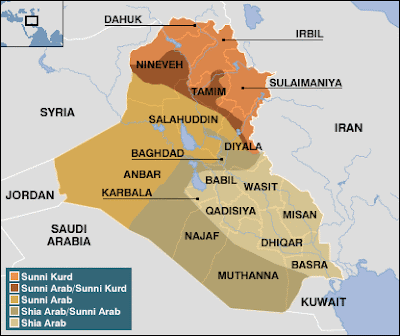

 casualties by province; general ethnicities by province; northen cities
casualties by province; general ethnicities by province; northen cities
link: MG Mixon, new guy on the block, gives a view from the North:
- Two of six Provinces quiet (Sulaymaniyah, Dahuk) area of 11 million people the size of Pennsylvania, roughly.
- At-Takim (Kirkuk) and Salah ad-Din suffer attacks on infrastructure
- Diyala (Ba'qubah, etc.) terorrist induced sectarian violence, with militia counter-attacks and corruption of police/army
- Nineveh - today (Dec 1) gets first division completely solely under IGFC (Iraqi Ground Froces Control)
Police, army, and border security forces -- all in play
Five divisions to be completely under IGFC by February.
I got the sense that training was going to be 'on-the-job', to accelerate the transitions, rather than via an approach of 'schoolroom first' and field-experience later (cf. "mobile training teams" ...).
Little comment on the role of the Peshmurga.
UPDATES LACK STRATEGIC CONTEXT
We get a sense of some forward motion from these snap-shot pictures. Some things are moving in the right direction.
What is the target structure of the Iraqi forces and what is the projected percentage completion? Perhaps four divisions is enough, but the size of battlions can vary, so its not clear how many this involves. 36,000 police is impressive, but how many more are needed to reach critical mass or widely accepted civilian protection ratios?
Background:
During the late 1970s and the mid-1980s, the Iraqi armed forces underwent many changes in size, structure, arms supplies, hierarchy, deployment, and political character. Between 1980 and the summer of 1990 Saddam boosted the number of troops in the Iraqi military from 180,000 to 900,000, creating the fourth-largest army in the world. With mobilization, Iraq could have raised this to 2 million men under arms--fully 75% of all Iraqi men between ages 18 and 34. The number of tanks in the Iraqi military rose from 2,700 to 5,700 and artillery pieces went from 2,300 to 3,700.
The regular Army in mid-1990 consisted of more than 50 divisions, additional special forces brigades, and specialized forces commands composed of maneuver and artillery units. Although most divisions were infantry, the Army had several armored and mechanized divisions. Some armored units had a small amount of modern Western and Soviet equipment, but most of the Army had 1960s-vintage Soviet and Chinese equipment. Training and equipment readiness of Army units varied greatly, ranging from good in the divisions that existed before the Iran-Iraq war, to poor in the largely conscript infantry formations.
http://www.globalsecurity.org/military/world/iraq/army.htm

No comments:
Post a Comment